英语-倒装句用法
英语倒装句的归纳总结

英语倒装句是一种特殊的句子结构,它指的是将谓语动词(或助动词)放在主语前面的句子。
根据倒装的程度,英语倒装句分为完全倒装和部分倒装。
下面我们详细地归纳和总结英语倒装句的类型和用法。
一、完全倒装1. 用于"there be" 句型。
例如:- There is a book on the table.(桌子上有一本书。
)- There will be a party next week.(下周将有一个聚会。
)2. 用于here, there, now, then 等不及物动词主语的句型中,或以in, out, up, down, away 等副词开头的句子里,以表示强调。
例如:- Here comes the bus.(公交车来了。
)- There goes the bell.(铃响了。
)- Now it's your turn.(现在轮到你了。
)3. 当句首状语为表示地点的介词词组时,也常将其全部倒装。
例如:- Outside the door stands a statue.(门外有一尊雕像。
)- From the top of the mountain, we can see the whole city.(从山顶上,我们可以看到整个城市。
)4. 表语置于句首时,倒装结构为"表语连系动词主语"。
例如:- Beautiful it is!(真美啊!)- Rarely has he been late.(他很少迟到。
)二、部分倒装1. 用于so that, so...that... 等句型中,将so 所修饰的形容词或副词置于句首,so 从句用倒装。
例如:- So loudly did he speak that everyone heard him.(他讲话声音如此之大,每个人都听到了。
)2. 用于疑问句中,助动词或情态动词放在主语前面。
例如:- Can you speak English?(你会说英语吗?)- Should we go there now?(我们现在去那里好吗?)3. 用于否定句中,助动词或情态动词放在主语前面。
英语倒装句语法总结
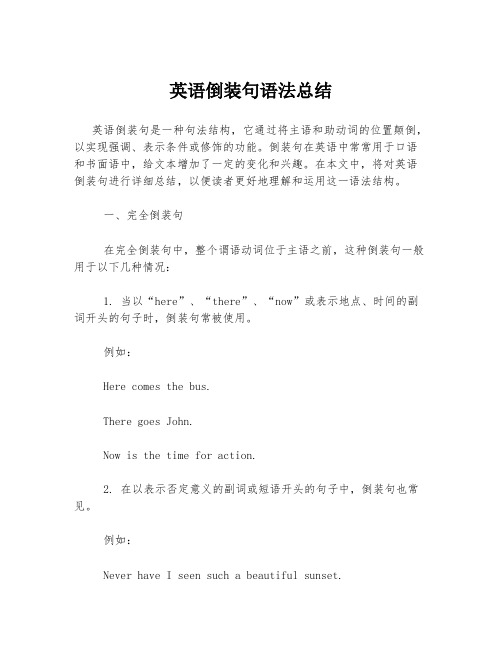
英语倒装句语法总结英语倒装句是一种句法结构,它通过将主语和助动词的位置颠倒,以实现强调、表示条件或修饰的功能。
倒装句在英语中常常用于口语和书面语中,给文本增加了一定的变化和兴趣。
在本文中,将对英语倒装句进行详细总结,以便读者更好地理解和运用这一语法结构。
一、完全倒装句在完全倒装句中,整个谓语动词位于主语之前,这种倒装句一般用于以下几种情况:1. 当以“here”、“there”、“now”或表示地点、时间的副词开头的句子时,倒装句常被使用。
例如:Here comes the bus.There goes John.Now is the time for action.2. 在以表示否定意义的副词或短语开头的句子中,倒装句也常见。
例如:Never have I seen such a beautiful sunset.Not only is she talented, but she is also kind-hearted.3. 在以“only”开头修饰状语从句的句子中,倒装句也经常使用。
例如:Only when you face your fears can you overcome them.Only in this way can the problem be solved.二、部分倒装句部分倒装句中,只将助动词或情态动词放在主语之前,而将主语与谓语动词的位置维持原状。
部分倒装句常用于以下几种情况:1. 当以否定副词“never”、“seldom”或“rarely”开头时,部分倒装句可以被采用。
例如:Never have I been so happy.Seldom does he complain about anything.2. 在以“so”或“such”引导的句子中,为了表达强调,可以使用部分倒装句。
例如:So tired was she that she fell asleep on the couch.Such is the power of love that it can conquer all obstacles.3. 在以“not”开头的句子中,为了增强否定的语气,常常使用部分倒装句。
英语:特殊句式-倒装句

倒装句是高考考查的重点句式之一。 我们应当熟记完全倒装、部分倒装 及特殊倒装结构的有关句式。
下面,我们就以下几个方面来对倒 装句进行讨论。
一、倒装句的概念 二、倒装句的类型 三、倒装结构的用法及注意点 四、倒装句习题精选
一、倒装句的概念
在英语中,正常语序为主语在前,谓语在后。如果将谓 语的全部或一部分提到主语的前面,这种语序就叫倒装。
e.g. ① Isn’t it interesting! 真有趣! ② May you succeed! 祝您成功! ③ Long live the people! 人民万岁!
(8) 直接引语的一部分或全部位于句首,主句用完 全倒装
e.g. “ You’d better it at once”, said his mother. 注: 这种用法中常用谓语动词为say, think, ask, cry等。
(6)当句子中作表语的形容词、过去分词等较短,而主语相 对比较长,为了保持句子平衡而将表语前置时,句子的主谓 语也应完全倒装。 e.g. ① Gone are the days when they could do what they liked to the Chinese people. ② Present at the meeting were some scientists from China. (7)表示感叹、祝愿的句子
e.g. ① ——My room gets very cold at night. ——So does mine. ② I don’t like football. Neither does he.
注:如果句意表示肯定或附和 “的确如此”时,句子不用倒装 e.g. —— It’s hot. —— So it is.(的确如此)
英语倒装句用法
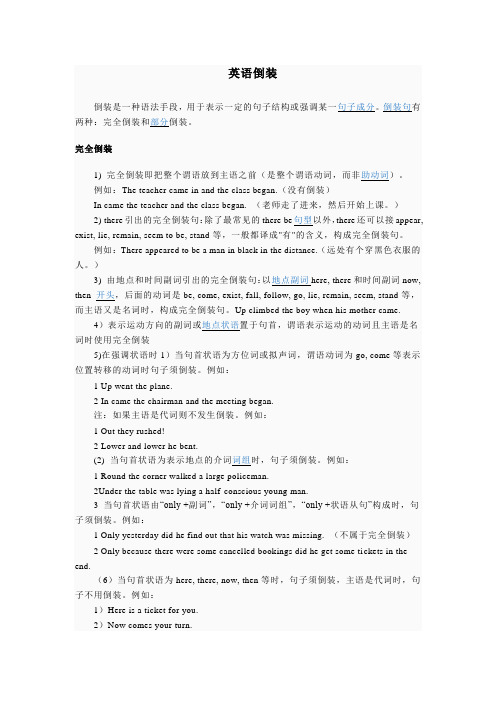
英语倒装倒装是一种语法手段,用于表示一定的句子结构或强调某一句子成分。
倒装句有两种:完全倒装和部分倒装。
完全倒装1) 完全倒装即把整个谓语放到主语之前(是整个谓语动词,而非助动词)。
例如:The teacher came in and the class began.(没有倒装)In came the teacher and the class began. (老师走了进来,然后开始上课。
)2) there引出的完全倒装句:除了最常见的there be句型以外,there还可以接appear, exist, lie, remain, seem to be, stand等,一般都译成"有"的含义,构成完全倒装句。
例如:There appeared to be a man in black in the distance.(远处有个穿黑色衣服的人。
)3) 由地点和时间副词引出的完全倒装句:以地点副词here, there和时间副词now, then 开头,后面的动词是be, come, exist, fall, follow, go, lie, remain, seem, stand等,而主语又是名词时,构成完全倒装句。
Up climbed the boy when his mother came.4)表示运动方向的副词或地点状语置于句首,谓语表示运动的动词且主语是名词时使用完全倒装5)在强调状语时1)当句首状语为方位词或拟声词,谓语动词为go, come等表示位置转移的动词时句子须倒装。
例如:1 Up went the plane.2 In came the chairman and the meeting began.注:如果主语是代词则不发生倒装。
例如:1 Out they rushed!2 Lower and lower he bent.(2) 当句首状语为表示地点的介词词组时,句子须倒装。
英语倒装句的用法归纳
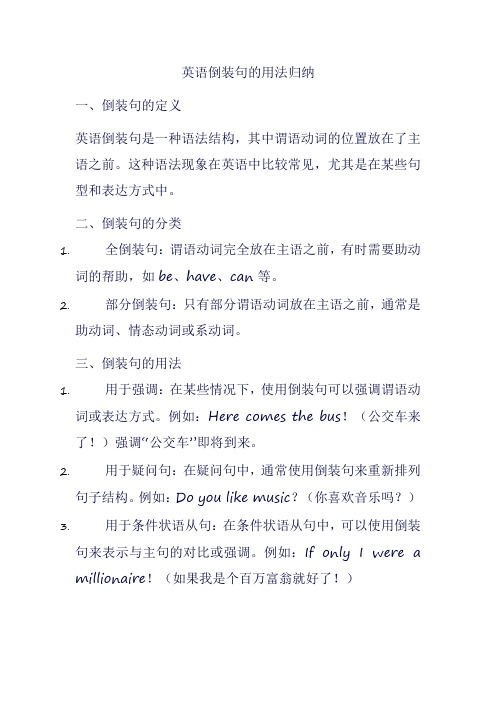
英语倒装句的用法归纳一、倒装句的定义英语倒装句是一种语法结构,其中谓语动词的位置放在了主语之前。
这种语法现象在英语中比较常见,尤其是在某些句型和表达方式中。
二、倒装句的分类1.全倒装句:谓语动词完全放在主语之前,有时需要助动词的帮助,如be、have、can等。
2.部分倒装句:只有部分谓语动词放在主语之前,通常是助动词、情态动词或系动词。
三、倒装句的用法1.用于强调:在某些情况下,使用倒装句可以强调谓语动词或表达方式。
例如:Here comes the bus!(公交车来了!)强调“公交车”即将到来。
2.用于疑问句:在疑问句中,通常使用倒装句来重新排列句子结构。
例如:Do you like music?(你喜欢音乐吗?)3.用于条件状语从句:在条件状语从句中,可以使用倒装句来表示与主句的对比或强调。
例如:If only I were a millionaire!(如果我是个百万富翁就好了!)4.用于让步状语从句:在让步状语从句中,可以使用倒装句来表示转折关系。
例如:Try to find a way to solve the problem!(试着找到解决问题的方法!)5.用于虚拟语气:在虚拟语气中,可以使用倒装句来表示与实际情况相反的情况。
例如:If I were you,I would go to the party.(如果我是你,我会去参加派对。
)6.用于某些固定句型:有些固定句型要求使用倒装句。
例如:“Hardly had she sat down when the phone rang.”(她刚坐下电话就响了。
)7.表示惊讶、感叹、讽刺等情绪时也可以使用倒装句。
例如:How could you do such a thing!(你怎么能做出这种事!)四、倒装句的用法归纳总结1.英语倒装句是一种语法结构,主要有全倒装句和部分倒装句两种类型。
2.使用倒装句可以强调谓语动词或表达方式,也可以用于疑问句、条件状语从句、让步状语从句和虚拟语气等语法结构中。
英语倒装句的用法及举例
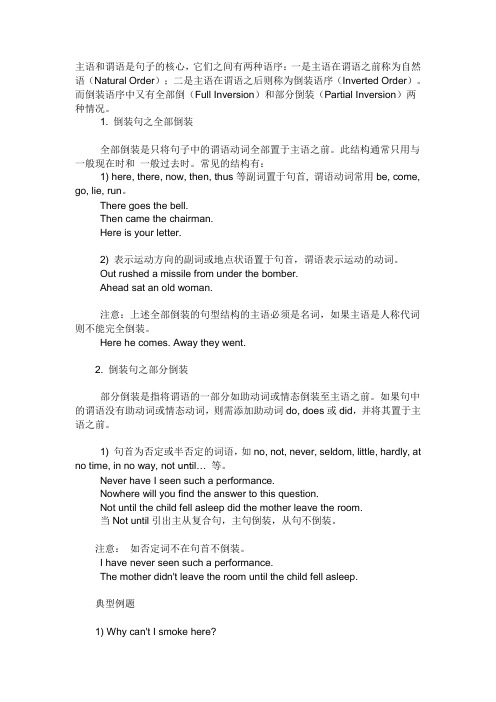
主语和谓语是句子的核心,它们之间有两种语序:一是主语在谓语之前称为自然语(Natural Order);二是主语在谓语之后则称为倒装语序(Inverted Order)。
而倒装语序中又有全部倒(Full Inversion)和部分倒装(Partial Inversion)两种情况。
1. 倒装句之全部倒装全部倒装是只将句子中的谓语动词全部置于主语之前。
此结构通常只用与一般现在时和一般过去时。
常见的结构有:1) here, there, now, then, thus等副词置于句首, 谓语动词常用be, come, go, lie, run。
There goes the bell.Then came the chairman.Here is your letter.2) 表示运动方向的副词或地点状语置于句首,谓语表示运动的动词。
Out rushed a missile from under the bomber.Ahead sat an old woman.注意:上述全部倒装的句型结构的主语必须是名词,如果主语是人称代词则不能完全倒装。
Here he comes. Away they went.2. 倒装句之部分倒装部分倒装是指将谓语的一部分如助动词或情态倒装至主语之前。
如果句中的谓语没有助动词或情态动词,则需添加助动词do, does或did,并将其置于主语之前。
1) 句首为否定或半否定的词语,如no, not, never, seldom, little, hardly, at no time, in no way, not until… 等。
Never have I seen such a performance.Nowhere will you find the answer to this question.Not until the child fell asleep did the mother leave the room.当Not until引出主从复合句,主句倒装,从句不倒装。
英语倒装句用法经典总结

英语倒装句用法经典总结1.完全倒装句:主语和谓语动词完全倒置。
如:- Never have I seen such a beautiful sunset.(我从未见过如此美丽的日落。
)- Little did he know about the problem.(他对问题一无所知。
)2.部分倒装句:只将助动词或情态动词和主语进行倒置。
如:- Can you swim?(你会游泳吗?)- Should you have any questions, please let me know.(如果你有任何问题,请告诉我。
)3.如果句子以表示地点的副词或介词短语开头,也需要进行倒装。
如:- On the top of the mountain stood a small cabin.(在山顶上有一间小木屋。
)4.如果句子以表示否定意义的副词或介词短语开头,也需要进行倒装。
如:- Under no circumstances will I allow that to happen.(无论如何,我都绝不容许那种事情发生。
5. 在条件句中,如果主语和谓语动词之间使用“had”,“were”或“should”时,需要进行倒装。
如:- Had I known it earlier, I would have prepared better.(要是早知道这个,我会准备得更好。
)- Were I you, I would apologize.(要是我是你,我会道歉。
)以上是英语倒装句的几种常见用法,不同的倒装句用法可以根据具体的语境和语法规则进行灵活运用。
高三英语语法讲解----倒装句

主句
从句
I did not know the truth until I saw the pistachio nuts.
Not until I saw the pistachio nuts did I know the truth.
until从句不倒装
not主句半倒装(一般疑问பைடு நூலகம்构)
Page 17
二、部分倒装
Page 15
二、部分倒装
部分倒装:将谓语动词的一部分(助动词/系动词/情态动词)置于主语前 情况1:当否定词或者带有否定意义的词或短语位于句首时 【学以致用】
I seldom arrange homework to students. Seldom do I arrange homework to students
他冲出去了
Out he rushed.
注意: 如果主语为人称代词,则不需要倒装。
Page 10
一、全部倒装
全部倒装:全部谓语放在主语之前 情况2:地点方位介词置于句首时 如on the wall, under the tree, in front of the house, in the middle of the room等
部分倒装:将谓语动词的一部分(助动词/系动词/情态动词)置于主语前 情况1:当否定词或者带有否定意义的词或短语位于句首时 特殊用法2:not only…but also【前倒后不倒】 My brother not only cheated me out of my money but also insulted my intelligence. Not only did my brother cheat me out of my money but also insulted my intelligence. 但not only...but also...连接主语时,不倒装。 Not only the mother but also the children are sick. 特殊用法3:“一……就……”句型的倒装 Hardly/Scarcely/Barely had + 主语 + done when + 主 + 谓 Hardly had he sworn to god when it thundered. No sooner had + 主语 + done than 主 + 谓 No sooner had he sworn to god than it thundered.
英语倒装句的使用方法

英语倒装句的使用方法倒装句在英语语法中是一个重要的结构,它可以改变句子的语序,使得表达更加生动、强调更为突出。
本文将介绍英语倒装句的使用方法,帮助读者理解并正确运用这一语法结构。
一、倒装句的基本形式倒装句的基本形式是将谓语动词的助动词或情态动词置于主语之前,可以用于陈述句、疑问句和条件句中。
以下是一些常见的倒装句的形式:1. 完全倒装:将助动词或情态动词置于主语之前,主语紧随在后。
例句1:Never have I seen such a beautiful sunset.例句2:Not only does she speak English fluently, but she also speaks French.2. 部分倒装:只将谓语动词的助动词或情态动词置于主语之前。
例句1:Have you finished your homework?例句2:Can she play the piano?二、倒装句的用法及注意事项1. 当句子以表示地点、方向、方式等的副词或短语开头时,可以使用完全倒装。
例句1:Under the tree sat a group of children, laughing and chatting.例句2:On the top of the hill stands a lonely house.2. 在表示否定意义的副词或词组在句首时,可以使用完全倒装。
例句1:Not only did he fail the exam, but he also lost his scholarship.例句2:Never have I been so disappointed.3. 在条件句中,为了强调条件而将“if”或“unless”置于句首时,可以使用完全倒装。
例句1:Should you need any assistance, please do not hesitate to contact us.例句2:Were it not for her guidance, I would not have succeeded.4. 在一些固定的短语或句型中,也常常使用倒装句。
英语倒装句的用法归纳总结
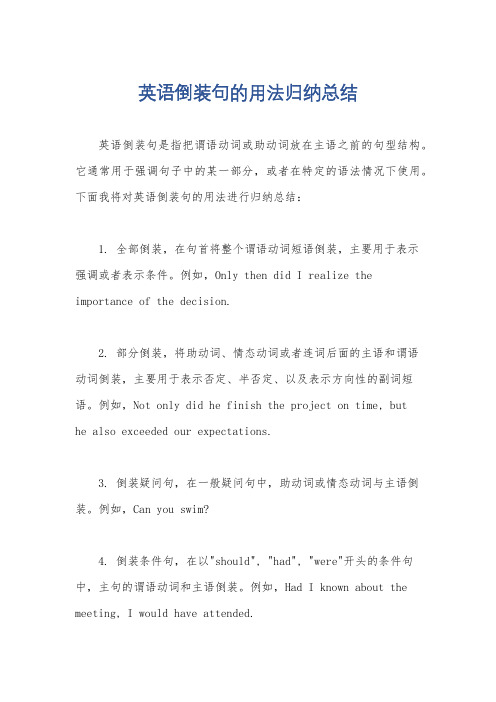
英语倒装句的用法归纳总结
英语倒装句是指把谓语动词或助动词放在主语之前的句型结构。
它通常用于强调句子中的某一部分,或者在特定的语法情况下使用。
下面我将对英语倒装句的用法进行归纳总结:
1. 全部倒装,在句首将整个谓语动词短语倒装,主要用于表示
强调或者表示条件。
例如,Only then did I realize the importance of the decision.
2. 部分倒装,将助动词、情态动词或者连词后面的主语和谓语
动词倒装,主要用于表示否定、半否定、以及表示方向性的副词短语。
例如,Not only did he finish the project on time, but
he also exceeded our expectations.
3. 倒装疑问句,在一般疑问句中,助动词或情态动词与主语倒装。
例如,Can you swim?
4. 倒装条件句,在以"should", "had", "were"开头的条件句中,主句的谓语动词和主语倒装。
例如,Had I known about the meeting, I would have attended.
5. 倒装句型用于表示方向性的副词短语,如,Here comes the bus.
总的来说,英语倒装句的使用有一定的规律,主要用于强调、
条件句、疑问句和特定的副词短语。
在写作和口语表达中,合适地
运用倒装句可以使语言更加生动有力。
希望以上总结对你有所帮助。
(完整版)英语倒装句的用法归纳

英语部分倒装用法归纳1. 否定副词位于句首时的倒装在正式文体中,never, seldom, rarely, little, hardly, scarcely, no sooner, no longer, nowhere 等含有否定意义的副词若位于句首,则其后要用部分倒装:I shall never forgive him. / Never shall I forgive him. 我永远不会宽恕他。
He seldom goes out for dinner. / Seldom does he go out for dinner. 他很少出去吃饭。
She hardly has time to listen to music. / Hardly does she have time to listen to music. 她几乎没时间听音乐。
He little realizes how important this meeting is. / Little does he realize how important this meeting is. 他不甚明白这个会议的重要性。
We had no sooner reached the airport than the plane took off. / No sooner had we reached the airport than the plane took off. 我们刚到机场,飞机就起飞了。
【注意】(1) 对于not…until句型,当not until…位于句首时,其后的主句要用倒装语序:He didn’t leave the ro om until the rain stopped. / Not until the rain stopped did he leave the room. 雨停了之后他才离开这房间。
(2) 某些起副词作用的介词短语,由于含有否定词,若位于句首,其后要用部分倒装:On no accounts must this switch be touched. 这个开关是绝不能触摸的。
倒装句的用法与注意事项

倒装句的用法与注意事项倒装句是英语语法中一种常用的语法结构,它在句子中把谓语动词或者其他特定成分放在主语之前,以达到强调、插入语效果或者改变语序的目的。
倒装句的使用能够提升语言的表达力和变化句子的节奏。
在本文中,我们将深入探讨倒装句的用法与注意事项。
一、倒装句的基本用法在英语中,倒装句根据具体的语法结构和用途可以分为以下几种:1.全部倒装句全部倒装句是指将谓语动词完全颠倒放在主语之前,通常用于表示地点、时间、条件、方式或情态动词等。
例如:a) In the garden sat two children, playing happily.(花园里坐着两个孩子,快乐地玩耍。
)b) Down the road came a group of cyclists.(沿着马路走来一群骑车的人。
)2.部分倒装句部分倒装句是指将助动词、情态动词或be动词与主语颠倒顺序,用于强调或借以表达一定的情感色彩。
例如:a) Never have I seen such a beautiful sunset.(我从未见过如此美丽的日落。
)b) Not only does she play the piano, but she also sings well.(她不仅会弹钢琴,还会唱歌。
)3.祈使句倒装在祈使句中,主语常常被省略,此时谓语动词直接放在句首,以表示命令、要求、建议等意义。
例如:a) Be quiet!(安静!)b) Sit down, please.(请坐。
)二、倒装句的注意事项在使用倒装句时,需要注意以下几点:1.仅适用于肯定句和祈使句倒装句通常只适用于肯定句和祈使句,而疑问句一般不使用倒装结构。
2.助动词、情态动词和be动词的倒装倒装结构通常在助动词、情态动词和be动词后面使用,而不适用于其他动词。
3.标点符号的使用在倒装句中,标点符号的使用要特别注意。
一般情况下,如果倒装结构作为句子的开始部分,则需要在倒装结构之后使用逗号隔开。
高考英语倒装句
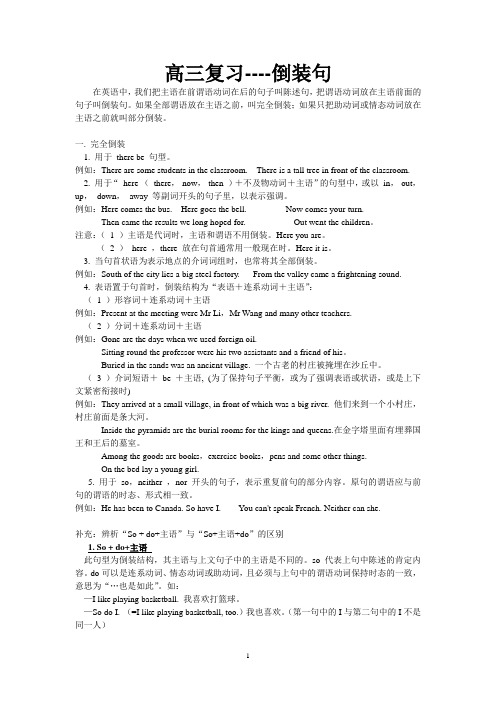
高三复习----倒装句在英语中,我们把主语在前谓语动词在后的句子叫陈述句,把谓语动词放在主语前面的句子叫倒装句。
如果全部谓语放在主语之前,叫完全倒装;如果只把助动词或情态动词放在主语之前就叫部分倒装。
一. 完全倒装1. 用于there be 句型。
例如:There are some students in the classroom. There is a tall tree in front of the classroom. 2. 用于“here (there,now,then )+不及物动词+主语”的句型中,或以in,out,up,down,away 等副词开头的句子里,以表示强调。
例如:Here comes the bus. Here goes the bell. Now comes your turn.Then came the results we long hoped for. Out went the children。
注意:(1 )主语是代词时,主语和谓语不用倒装。
Here you are。
(2 )here ,there 放在句首通常用一般现在时。
Here it is。
3. 当句首状语为表示地点的介词词组时,也常将其全部倒装。
例如:South of the city lies a big steel factory. From the valley came a frightening sound.4. 表语置于句首时,倒装结构为“表语+连系动词+主语”:(1 )形容词+连系动词+主语例如:Present at the meeting were Mr Li,Mr Wang and many other teachers.(2 )分词+连系动词+主语例如:Gone are the days when we used foreign oil.Sitting round the professor were his two assistants and a friend of his。
英语里倒装句的用法

英语里倒装句的用法英语倒装句的用法英语倒装句是英语中很重要的一种句型,难度相对也有点大。
你掌握了吗。
接下来小编在这里给大家带来英语倒装句的用法,我们一起来看看吧!英语倒装句的用法英语中常见的倒装:1. 在疑问句中。
Did you had your hair cut yesterday?2. 在there be 结构中。
There are several students in the classroom.3. 直接引语的一部分或全部放在句首时,有时也用倒装。
" Build up your self-confidence."; said the teacher.4. 在表示方向,地点的副词或某些介词词组开头的里,如there, here, out, in, up, down, away, in front of等,以示强调。
On the top of the hill stands an old temple.Away flew the bird.Out rushed the pupils.但主语是人称代词时,主语和谓语的语序不变。
Here it is.Away he went.5. 含有否定意义的副词或连词,如never, not, not only, little, seldom, hardly等,放在句首时。
Not only am l out-going and active, but also enthusiastic and optimistic.Never will he forget the first day to go to school.Hardly had I got out of the house when it began to rain.基本语序6. Only 所修饰的副词,介词短语或状语从句放在句首时。
Only in this way can you have a good command of a foreign language.Only if you put your mind into something can you get the best result of it.7. So , neither, nor引起的句子,表示前面的情况也适用于另一个人或事物时。
英语倒装句的用法
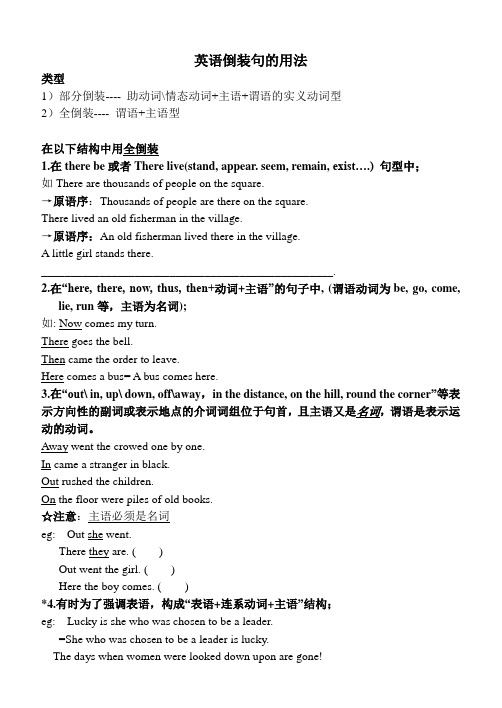
英语倒装句的用法类型1)部分倒装---- 助动词\情态动词+主语+谓语的实义动词型2)全倒装---- 谓语+主语型在以下结构中用全倒装1.在there be或者There live(stand, appear. seem, remain, exist….) 句型中;如There are thousands of people on the square.→原语序:Thousands of people are there on the square.There lived an old fisherman in the village.→原语序:An old fisherman lived there in the village.A little girl stands there.__________________________________________________.2.在“here, there, now, thus, then+动词+主语”的句子中, (谓语动词为be, go, come,lie, run等,主语为名词);如: Now comes my turn.There goes the bell.Then came the order to leave.Here comes a bus= A bus comes here.3.在“out\ in, up\ down, off\away,in the distance, on the hill, round the corner”等表示方向性的副词或表示地点的介词词组位于句首,且主语又是名词,谓语是表示运动的动词。
Away went the crowed one by one.In came a stranger in black.Out rushed the children.On the floor were piles of old books.☆注意:主语必须是名词eg: Out she went.There they are. ( )Out went the girl. ( )Here the boy comes. ( )*4.有时为了强调表语,构成“表语+连系动词+主语”结构;eg: Lucky is she who was chosen to be a leader.=She who was chosen to be a leader is lucky.The days when women were looked down upon are gone!_____________________________________________________________________ *5、在某些表示愿望的感叹句,全倒装。
英语学习--倒装句
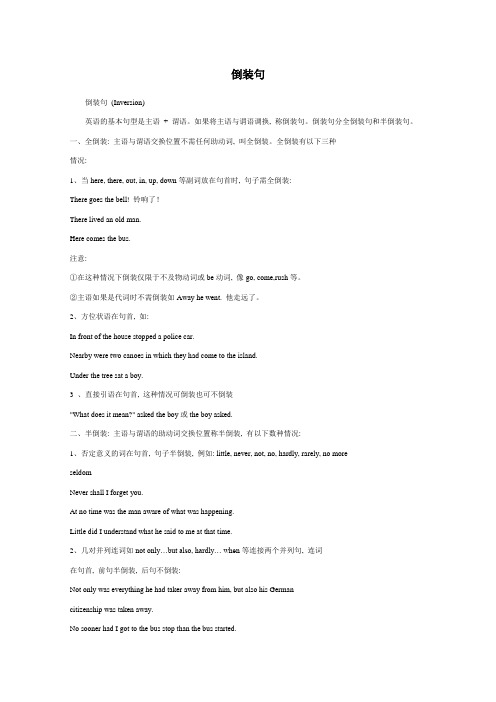
倒装句倒装句(Inversion)英语的基本句型是主语+ 谓语。
如果将主语与谓语调换, 称倒装句。
倒装句分全倒装句和半倒装句。
一、全倒装: 主语与谓语交换位置不需任何助动词, 叫全倒装。
全倒装有以下三种情况:1、当here, there, out, in, up, down等副词放在句首时, 句子需全倒装:There goes the bell! 铃响了!There lived an old man.Here comes the bus.注意:①在这种情况下倒装仅限于不及物动词或be动词, 像go, come,rush等。
②主语如果是代词时不需倒装如Away he went. 他走远了。
2、方位状语在句首, 如:In front of the house stopped a police car.Nearby were two canoes in which they had come to the island.Under the tree sat a boy.3 、直接引语在句首, 这种情况可倒装也可不倒装"What does it mean?" asked the boy或the boy asked.二、半倒装: 主语与谓语的助动词交换位置称半倒装, 有以下数种情况:1、否定意义的词在句首, 句子半倒装, 例如: little, never, not, no, hardly, rarely, no moreseldomNever shall I forget you.At no time was the man aware of what was happening.Little did I understand what he said to me at that time.2、几对并列连词如not only…but also, hardly… when等连接两个并列句, 连词在句首, 前句半倒装, 后句不倒装:Not only was everything he had taker away from him, but also his Germancitizenship was taken away.No sooner had I got to the bus stop than the bus started.A.came the hour B.the hour cameC.comes the hour D.the hour is coming5、Only when he started to explain the reason for this.A.she realized B.did she realizeC.she had realized D.had she realized6、 succeed in doing anything.A.Only by working hard we canB.By only working hard we canC.Only by working hard can weD.Only we can by working hard7、Not for a moment the truth of your story.A.he has doubted B.he doubtsC.did he doubt D.he did doubt8、Nowhere else in the world cheaper tailoring than in Hong Kong. A.a tourist can find B.can a tourist findC.a tourist will find D.a tourist has found9、Hardly when the bus suddenly pulled away.A.they had got to the bus-stop B.they got to the bus-stopC.did they get to the bus-stop D.had they got to the bus -stop 10、Mary doesn’t speak French, and does Joan.A.not B.neither C.either D.so 11、—Do you know Jim quarreled with his brother? —I don’t know,. A.nor don’t I care B.nor do I careC.I don’t care neither D.I don’t care also12、Not until the early years of the 19th century what heat is.A.man did know B.man knewC.didn’t man know D.did man know13、After that we never saw her again nor from her.A.did we hear B.we heardC.had we heard D.we have heard14、John won the first prize in the contest. .A.So he did. B.So did he.C.So he did, too. D.So did he, too.15、,he doesn’t study well.A.As he is clever B.He is as cleverC.Clever as he is D.As clever he is16、You can never use my tape recorder. time should you touch that machine. A.At no B.At any C.Any D.No17、Scarcely the room the phone rang.A.I had entered…when B.Had I entered…thenC.had I entered…when D.have I entered…when18、Only save his life.A.can the doctor B.the doctor canC.will the doctor D.could the doctor19、Hardly anybody the boy , because he is rude.A.does like B.likes C.do like D.like20、So well that the teacher praised her.A.she had done her homeworkB.her homework had been doneC.did she do her homeworkD.she did her homework21、Only when to know him will you get along with him.A.do you come B.will you comeC.you come D.you will come22、Out , gun in hand.A.did he rush B.rushed heC.he rushed D.had he rushed23、He had promised me to come to the party ,and .A.so did he B.so he did C.so he would D.so would he 24、Into the sky the light blue smoke.A.went up B.up went C.did go up D.had gone up 25、Little about his own life at the meeting.A.did he talk B.he talkedC.he was talking D.had he talked26、Under no circumstances first use nuclear weapons.A.will China B.China will C.does China D.do China27、 taken that examination, she could have passed it .A.Were she B.Had she be able toC.If she would have D.Had she28、tomorrow , we would put off the match till next Monday.A.Should it rained B.Were it to rainC.If it would rain D.Had it rained29、Look, here .A.Mr. Brown comes B.does Mr. Brown comeC.comes Mr. Brown D.Mr. Brown has come30、Often us good advice.A.did she give B.she did giveC.she gave D.she has given31、Not until I began to work how much time I had wasted.A.didn’t I realize B.did I realizeC.I didn’t realize D.I realize32、Little about his own safety , though he was in great danger himself.A.does he care B.did he careC.he cares D.he cared33、began our new lesson.A.But B.Thus C.Such D.So that34、By no means look down upon the poor.A.we should B.we should notC.do we D.should we35、Only when 30 years old to learn English.A.was he , did he begin B.he was , he beganC.was he , he began D.he was ,did he begin36、Not once their plan.A.did they change B.they changedC.changed they D.they did changed37、“It’s very hot today.”“.”A.So it is B.So is it C.So does it D.So it does 38、A fish needs water and without water it will die.A.So does a man B.So will a manC.So it is with a man D.So is it with a man39、They arrived at the farmhouse, in front of which .A.sat a small boy B.a small boy satC.is sitting a small boy D.a small boy sitting40、Society has changed and in it .A.so have the people B.so the people haveC.the people have so D.have the people soⅡ、改错41、Only when was he 50 years old did he begin to learn French.42、Little she knew Tom was was badly ill43、Turn to the right and there are you.44、And all around the fox in a circle was dogs.45、—You can learn English well.—So can we.46、I dare climb this tall tree, but do you?47、Not once he kept his promise.48、Many a time he has given us some good advice.49、Such a noise there was that I couldn’t work in the room.50、Only does my mother understand me.【答案】:Ⅰ、1、B2、C3、A4、A5、B6、C7、C8、B9、D 10、B 11、B 12、D13、A 14、A 15、C 16、A 17、C 18、B19、B 20、C 21、C 22、C 23、B 24、A25、A 26、A 27、D 28、B 29、C 30、A31、B 32、B 33、B 34、D 35、D 36、A37、A 38、C 39、A 40、AⅡ、41、was he —he was 倒装主句不倒装从句。
英语-倒装句用法

一、部分倒装:在正式文体中,等含有否定意义的副词若位于句首,则其后要用部分倒装:I shall never forgive him. / Never shall I forgive him. 我永远不会宽恕他。
He seldom goes out for dinner. / Seldom does he go out for dinner. 他很少出去吃饭。
He little realizes how important this meetingis. / Little does he realize howimportant this meeting is. 他不甚明白这个会议的重要性。
注意:(1) 对于 not … until 句型,当 not until…位于句首时,其后的主句要用倒装语序:He didn’t leave the room until the rain stopped. / Not until the rain stopped did he leave the room. 雨停了之后他才离开这房间。
(2) 某些起副词作用的介词短语,由于含有否定词,若位于句首,其后要用部分倒装:On no accounts must this switch be touched. 这个开关是绝不能触摸的。
(3) 但是, in no time(立即,马上)位于句首时,其后无需用倒装语序:In no time he worked out the problem. 他马上就算出了那道题。
当一个状语受副词 only 的修饰且置于句首时,其后用部分倒装语序:Only then did he realize that he was wrong. 到那时他才意识到他错了。
Only in this way are you able to do it well. 你只有用这种方法才能把它做好。
”位于句首时的倒装副词 so 后接形容词或副词位于句首时,其后用部分倒装:So cold was the weather that we had to stay at home. 天气太冷,我们只好呆在家里。
倒装句的用法及注意事项

倒装句的用法及注意事项倒装句是英语语法中的一种句子结构,通过将主语和动词的位置颠倒,以强调某一成分或改变句子的语气。
倒装句是英语中的一个重要语法现象,掌握倒装句的用法和注意事项对于提高英语表达的准确性和流利性至关重要。
本文将介绍倒装句的常见用法,并提供一些注意事项供大家参考。
一、完全倒装句完全倒装句是指将助动词、情态动词、系动词或某些动词位于句首,主语位于谓语动词之后的一种句子结构。
常见的情景有:1. 当以表示地点、频率、方向、方式、原因等的副词或短语作为句首状语时,需要使用完全倒装句。
例如:Out of the blue came a loud noise.(突然传来一阵巨响。
)Not until last night did I realize my mistake.(直到昨晚我才意识到我的错误。
)2. 当表示否定的副词或短语放在句首时,需要使用完全倒装句。
例如:Never have I seen such a beautiful sunset.(我从未见过如此美丽的日落。
)Under no circumstances should you give out your personal information.(在任何情况下都不应该泄露个人信息。
)3. 当以倒装词组开头时,需要使用完全倒装句。
例如:Not only does he play the piano, but he also sings.(他不仅会弹钢琴,还会唱歌。
)In no way can we ignore the importance of education.(我们无论如何都不能忽视教育的重要性。
)二、部分倒装句部分倒装句是指将助动词或情态动词置于主语之前,而将主语和谓语动词之间的顺序保持不变的句子结构。
常见的情景有:1. 当以否定词开头时,需要使用部分倒装句。
例如:Never have I been so disappointed.(我从未如此失望过。
- 1、下载文档前请自行甄别文档内容的完整性,平台不提供额外的编辑、内容补充、找答案等附加服务。
- 2、"仅部分预览"的文档,不可在线预览部分如存在完整性等问题,可反馈申请退款(可完整预览的文档不适用该条件!)。
- 3、如文档侵犯您的权益,请联系客服反馈,我们会尽快为您处理(人工客服工作时间:9:00-18:30)。
倒装句用法总结归纳
一、部分倒装:
1.否定副词位于句首时的倒装
在正式文体中,never, seldom, rarely, little, hardly, scarcely, no sooner, no longer, nowhere等含有否定意义的副词若位于句首,则其后要用部分倒装:
I shall never forgive him. / Never shall I forgive him. 我永远不会宽恕他。
He seldom goes out for dinner. / Seldom does he go out for dinner. 他很少出去吃饭。
He little realizes how important this meeting is. / Little does he realize how important this meeting is. 他不甚明白这个会议的重要性。
注意:
(1) 对于not…until句型,当not until…位于句首时,其后的主句要用倒装语序:
He didn’t leave the room until the rain stopped. / Not until the rain stopped did he leave the room. 雨停了之后他才离开这房间。
(2) 某些起副词作用的介词短语,由于含有否定词,若位于句首,其后要用部分倒装:
On no accounts must this switch be touched. 这个开关是绝不能触摸的。
(3) 但是,in no time(立即,马上)位于句首时,其后无需用倒装语序:
In no time he worked out the problem. 他马上就算出了那道题。
2.“only+状语”位于句首时的倒装
当一个状语受副词only的修饰且置于句首时,其后用部分倒装语序:
Only then did he realize that he was wrong. 到那时他才意识到他错了。
Only in this way are you able to do it well. 你只有用这种方法才能把它做好。
3.“so+adj. / adv.”位于句首时的倒装
副词so后接形容词或副词位于句首时,其后用部分倒装:
So cold was the weather that we had to stay at home. 天气太冷,我们只好呆在家里。
So sudden was the attack that we had no time to escape. 袭击来得非常突然,我们来不及逃跑。
4.“so+助动词+主语”倒装
当要表示前面提出的某一肯定的情况也同样适合于后者,通常就要用“So+助动词+主语”这种倒装结构:
You are young and so am I. 你年轻,我也年轻。
If he can do it, so can I. 要是他能做此事,我也能。
注意:
(1) 若前面提出某一否定的情况,要表示后者也属于同样的否定情况,则应将其中的so 改为neither或nor:
You aren’t young and neither am I. 你不年轻,我也不年轻。
She hasn’t read it and nor have I. 她没有读它,我也没有读。
(2) 注意该结构与表示强调或同意的“so+主语+特殊动词”结构的区别:
"It was cold yesterday." "So it was." “昨天很冷。
”“的确很冷。
”
"Father, you promised." "Well, so I did." “爸爸,你答应过的。
”“嗯,是答应过。
”
5. 由“not only…but also”引出的倒装
当not only…but also位于句首引出句子时,not only 后的句子通常用部分倒装形式: Not only is he a teacher, but he is also a poet. 他不仅是一位教师,而且是一位诗人。
Not only did he speak more correctly, but he spoke more easily. 不仅他讲得更正
确,也讲得更不费劲了。
6. 虚拟条件句的省略与倒装
当if引导的虚拟条件从句中含有had, were, should等时,如将if省略,则要将had, were, should等移到主语前,构成倒装句:
Had you come yesterday, you would have seen him.若你昨天来,你就会见到他了。
Should you require anything give me a ring. 如果需要什么,可以给我打电话。
Were it not for your help, I would still be homeless. 要不是你帮助,我会仍然无家可归。
注意:
省略if后提前的had不一定是助动词:
Had I money, I would buy it. 假若我有钱,我就会买它。
二、完全倒装:
1.here 和there位于句首时的倒装
表示地点的here和 there位于句首时,其后用完全倒装形式。
这类倒装句的谓语通常是动词be和come, go等表示移动或动态的不及物动词:
Here’s Tom. 汤姆在这里。
Here comes the bus. 公共汽车来了。
There goes the last train. 最后一班火车开走了。
注意:
(1) 以上倒装句中的谓语动词come和go不能用进行时态,即不能说 Here is coming the bus。
(2) 若主语为代词,则不倒装:
Here I am. 我在这儿。
/ 我来了。
Here it comes. 它来了。
(3) 其中的动词有时也可能是stand, lie, live等表示状态的动词(表示存在):
There stood a desk against the wall. 靠墙放着一张书桌。
Once upon a time there lived a man known by the name of Beef. 从前有个人名叫比夫。
2.away和down等位于句首时的倒装
地点副词away, down, in, off, out, over, round, up等位于句首时,其后用完全倒装语序。
这类倒装句的谓语通常表示动态的不及物动词:
Away went the runners. 赛跑选手们跑远了。
Round and round flew the plane. 飞机盘旋着。
The door opened and in came Mr Smith. 门开了,史密斯先生进了来。
注意:
若主语为人称代词,则不能用倒装:
Away he went. 他跑远了。
3.状语或表语位于句首时的倒装
为了保持句子平衡或使上下文衔接紧密,有时可将状语或表语置于句首,句中主语和谓语完全倒装:
Among these people was his friend Jim. 他的朋友吉姆就在这些人当中。
By the window sat a young man with a magazine in his hand. 窗户边坐着一个年轻人,手里拿着一本杂志。
注意:
在表语置于句首的这类倒装结构中,要注意其中的谓语应与其后的主语保持一致,而不是
与位于句首的表语保持一致。
比较:
In the box was a cat. 箱子里是一只猫。
In the box were some cats. 箱子里是一些猫。
4. 分词和不定式置于句首的倒装
有时为了强调,可将谓语部分的现在分词、过去分词或不定式置于句首,从而构成倒装: Buried in the sands was an ancient village. 一个古老的村庄被埋在这沙土之中。
To be carefully considered are the following questions. 下列问题要仔细考虑。
